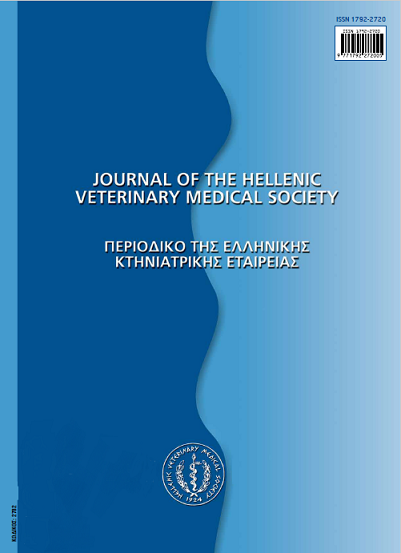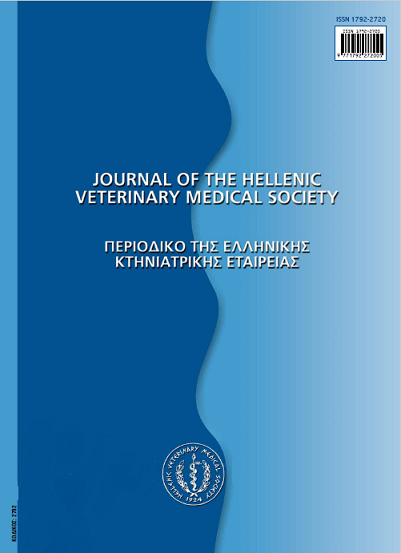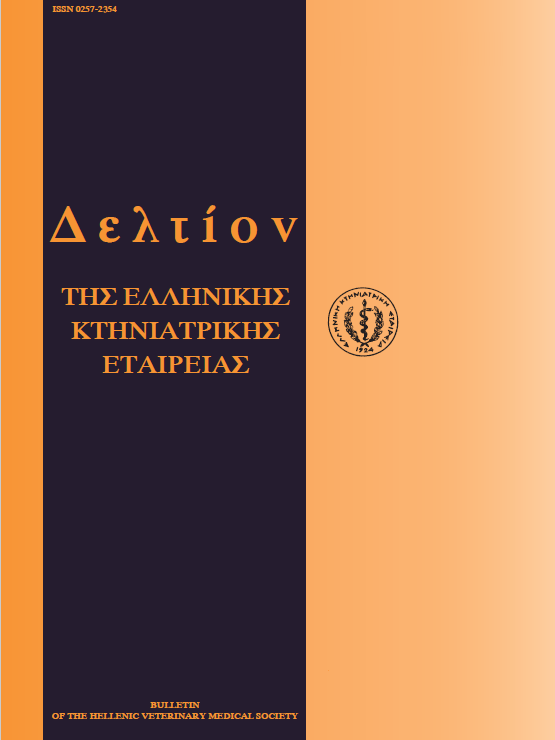Νεότερα δεδομένα πάνω στην ηπατοζωόνωση του σκύλου

Περίληψη
Η ηπατοζωόνωση στο σκύλο προκαλείται απόδυο είδη πρωτόζωων του γένους Hepatozoon. Το παλαιότεραγνωστό είδος Η. canis μεταδίδεται με τον κρότωνα Rhipicephalus sanguineus και έχει σχεδόν παγκόσμια γεωγραφική εξάπλωση,ενώ το σχετικά πρόσφατα ταυτοποιημένο Η. americanum μεταδίδεταιμε τον Amblyomma maculatum και μέχρι σήμερα έχει διαπιστωθεί μόνο στις Ηνωμένες Πολιτείες. Το Η. canis, έχοντας προσαρμοστεί στο σκύλο, προκαλεί συνήθως υποκλινική ή ήπια κλινική νόσο. Στην τελευταία περίπτωση, σημαντικό ρόλο φαίνεται να παίζει η χορήγηση ανοσοκατασταλτικών ουσιών και τα συνυπάρχοντα νοσήματα. Η ανορεξία, η κατάπτωση, ο λήθαργος, οπυρετός, η λεμφαδενοπάθεια και η απώλεια του σωματικού βάρους αποτελούν τις συνηθέστερες κλινικές εκδηλώσεις. Η διάγνωση της ηπατοζωόνωσης, που οφείλεται στο Η. canis, βασίζεται στην ανεύρεση των γαμετοκυττάρωντου τελευταίου, στο κυτταρόπλασματων ουδετερόφιλων κυττάρων (συνήθως 1-5% των ουδετερόφιλων), σε επιχρίσματα αίματος υστέρα από χρώση Giemsa. Η χορήγηση διπροπιονικής ιμιδοκάρβης, σε συνδυασμό ή όχι με τη δοξυκυκλίνη, οδηγεί συνήθως σε κλινική ύφεση και εξαφάνιση της παρασιταιμίας, αν και οι υποτροπές δεν είναι σπάνιες. Το Η.americanum, αντίθετα, προερχόμενο πιθανότατα από κάποιο άλλο είδος ξενιστή και έχοντας ελάχιστα προσαρμοστεί στο σκύλο, προκαλεί ένα χρόνιο καχεξιογόνο και συχνά θανατηφόρο νόσημα. Ο πυρετός, το γενικευμένο άλγος, η μυϊκή ατροφία και η απροθυμία ή η αδυναμία μετακίνησης του ζώου, που αποτελούν τις τυπικές κλινικές εκδηλώσεις, είναι το αποτέλεσμα της σοβαρής κοκκιωματώδους πολυμυίτιδας και των εκτεταμένων περιοστικών αλλοιώσεων. Η διάγνωση της ηπατοζωόνωσης, που οφείλεται στο Η.americanum, θα βασιστεί στην ιστοπαθολογική εξέταση των προσβεβλημένων μυών ή/και στην ανίχνευση των ειδικών αντισωμάτων στον ορό του αίματος, αφού η παρουσία των γαμετοκυττάρωνστα ουδετερόφιλα λευκοκύτταρα είναι πολύ σπάνια. Ο συνδυασμός τριμεθοπρίμης-σουλφαδιαζίνης, κλινδαμυκίνης και πυριμεθαμίνης και στη συνέχεια η μακροχρόνια χορήγηση της αντικοκκιδιακής ουσίας δεκοκινάτης επιτυγχάνει την κλινική ίαση και τη σημαντική αύξησητου χρόνου επιβίωσης, αν και οι υποτροπές είναι μάλλον συχνές.
Λεπτομέρειες άρθρου
- Πώς να δημιουργήσετε Αναφορές
-
MYLONAKIS (Μ.Ε. ΜΥΛΩΝΑΚΗΣ) M. E., PETANIDES (Θ. Α. ΠΕΤΑΝΙΔΗΣ) T. A., & KOUTINAS (Α. Φ. ΚΟΥΤΙΝΑΣ) A. F. (2017). Νεότερα δεδομένα πάνω στην ηπατοζωόνωση του σκύλου. Περιοδικό της Ελληνικής Κτηνιατρικής Εταιρείας, 55(2), 174–179. https://doi.org/10.12681/jhvms.15191
- Τεύχος
- Τόμ. 55 Αρ. 2 (2004)
- Ενότητα
- Review Articles
Οι συγγραφείς των άρθρων που δημοσιεύονται στο περιοδικό διατηρούν τα δικαιώματα πνευματικής ιδιοκτησίας επί των άρθρων τους, δίνοντας στο περιοδικό το δικαίωμα της πρώτης δημοσίευσης.
Άρθρα που δημοσιεύονται στο περιοδικό διατίθενται με άδεια Creative Commons 4.0 Non Commercial και σύμφωνα με την άδεια μπορούν να χρησιμοποιούνται ελεύθερα, με αναφορά στο/στη συγγραφέα και στην πρώτη δημοσίευση για μη κερδοσκοπικούς σκοπούς.
Οι συγγραφείς μπορούν να καταθέσουν το άρθρο σε ιδρυματικό ή άλλο αποθετήριο ή/και να το δημοσιεύσουν σε άλλη έκδοση, με υποχρεωτική την αναφορά πρώτης δημοσίευσης στο J Hellenic Vet Med Soc
Οι συγγραφείς ενθαρρύνονται να καταθέσουν σε αποθετήριο ή να δημοσιεύσουν την εργασία τους στο διαδίκτυο πριν ή κατά τη διαδικασία υποβολής και αξιολόγησής της.






